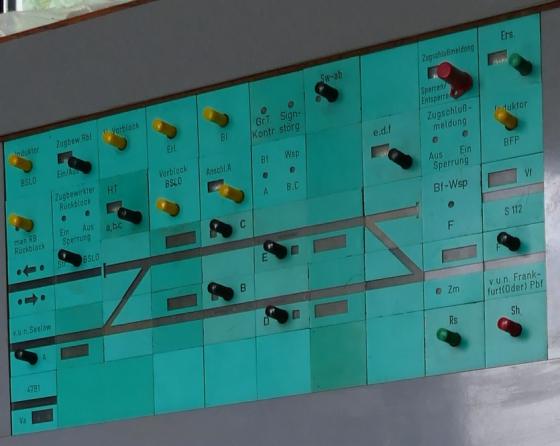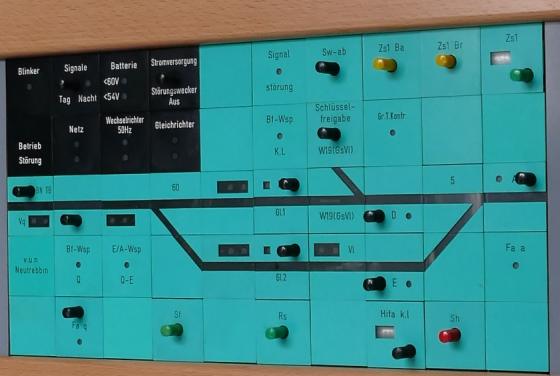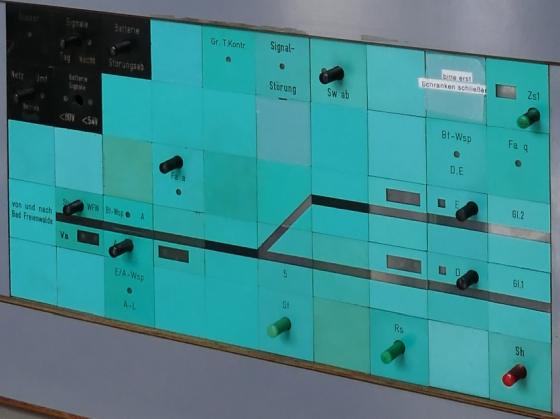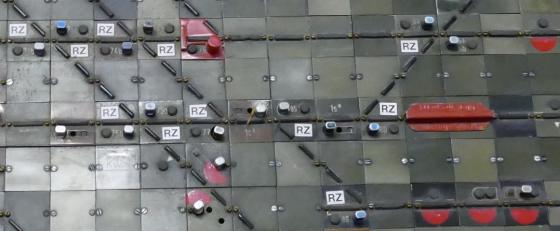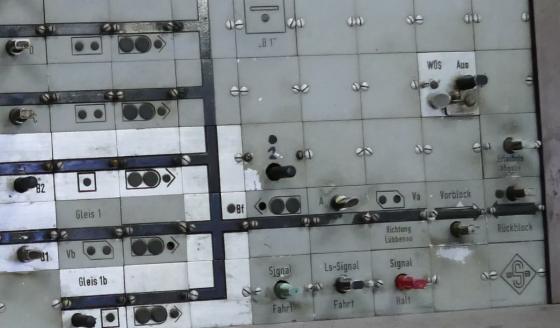Here is a posting with recent pictures, in the spirit of Jersey Mike's Position Light blog: A few very special signals, with most of their companions already extinct. They are called "Sk signals", which is short for "signal combination", and they were an attempt in the 1970s by the Deutsche Bundesbahn to reduce the number of lamps needed in signals.
Here is a short explanation of this signalling system (a German one can be found here at www.tf-ausbildung.de):
- Essentially, as in many other signal systems around the world, there are only three aspects indicated by a single lamp: Stop (red), expect to stop (yellow), and clear (green).
- A signal can either be a distant signal (indicated by a yellow plate), which will not show stop; or a stop signal (with a red plate), showing only stop or clear; or a combined distant and stop signal (red and yellow plate), which can show all three aspects.
- A reduced speed at the signal is indicated by an illuminated number above the signal, showing a tenth of the allowed speed in kph. A speed reduction to be expected at the next signal is shown in the same way below the signal.
- Various rules differing from the then standard H/V signalling system define how long a speed reduction extends; and what is to be done in the case of a malfunctioning signal (that's where the plates come in).
With the erection of a few solid state interlockings on the northern part of the line, most Sk signals have already been replaced with Ks signals. But between Augsburg and Gablingen, on the southernmost 10 kilometers, there are still Sk signals in operation; two of them are circularly headed distants, which are therefore the last two round signal heads in Germany. This is where Robert and I were headed two weeks ago, expecting a longer walk through the barren fields.
Before we were near the first such signal near Gablingen, a small industrial engine came round a curve with six cars from a "salt train" (what it actually carries, I do not know; that's just the name used by railway people thereabouts). We did not expect the small train, and were at an unfortunate location near the center of the curving track:
Locomotive 9 "Clara" of industrial park Gersthofen with "salt train" cars, 14.2.2022
Locomotive 9 "Clara" of industrial park Gersthofen with "salt train" cars, 14.2.2022
A short time later, the locomotive (Henschel DHG500C, builder's number 30924, built in 1964) came back empty. Here it can be seen near the level crossing near the "correctional facility" south of Gablingen:
Locomotive 9 "Clara" of industrial park Gersthofen, 14.2.2022
Locomotive 9 "Clara" of industrial park Gersthofen, 14.2.2022
Back to the Sk signals: Here is a sketch of the line from Gersthofen to Gablingen which shows the locations of these signals; the red markers indicate our photo-shoots.
- I use the symbols that usually indicate Ks signals, as there are no official Sk symbols.
- Edit 2.3.2022: After a comment by Niklas at my German posting, I have now marked the distants with their offical names, namely "V" (for "Vorsignal", i.e., distant signal) and the name of the corresponding stop signal in lowercase.
- Signals that stand back-to-back near the tracks are shown with their feet together in my diagram, thus they are located the wrong way round. By the way, on the interlocking panel at Gablingen (which I don't show here), they are placed even farther from their actual locations. If you'd like to know the actual locations of the signals, you should watch one of the many driver's cab rides of this line.
- Some further information (e.g. a link to DB's official track plan) and more images can be found at the Gablingen Gf entry at stellwerke.info.
Here is the first picture of an Sk distant signal. This is the distant for block signal 202, and it is one of the two remaining with a round screeen:
Sk distant signal V202 for combined block signal 202, Gablingen, 14.2.2022
In the middle between Gablingen and Gersthofen, there are four signals close together. Three of them are distant signals, one is a combined distant and block signal, with an additional subsidiary signal to be used in case of failures. All four signals have speed indicators below them, as the corresponding stop signals are home signals which can signal diverging routes into passing loops.
The pictures show that also distant signals have rectangular screens, for example the distants Va and Vaa shown here for Gablingen's home signals. The mixture of round and rectangular screens for the same type of signal seems confusing to me, but obviously part of the test was also to find out which of the two is suited better. Probably nobody expected these signals to survive 45 years and more ...
Here are my images:
Sk signals near the block between Gersthofen and Gablingen, 14.2.2022
Unfortunately, the sun was at a position that spoilt a clear image of the lit lamps:
Sk signals near the block between Gersthofen and Gablingen, 14.2.2022
Distant signal Vff100 near the block between Gersthofen and Gablingen, 14.2.2022
Distant signal Vff100 near the block between Gersthofen and Gablingen, 14.2.2022
Distant signal Vff100 near the block between Gersthofen and Gablingen, 14.2.2022
One can see that at the distant signal Va, the triangular screen of the speed indicator is missing. The signal book does not require it—only a yellow number is needed; but I would have expected that all four signals are equipped with the same screens. It seems that the original indicator was replaced at some time, as all newer ones do no longer have this triangular screen. This last picture also shows, finally, a train:
Sk signals near the block between Gersthofen and Gablingen, 14.2.2022
My diagram shows that there are a few more Sk signals thereabouts; I think I'll have to visit that place once more.

